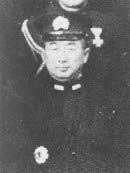Shōji Nishimura
Shōji Nishimura (西村 祥治, Nishimura Shōji, 30 November 1889 – 24 October 1944) was an admiral in the Imperial Japanese Navy during World War II.
Shōji Nishimura | |
|---|---|
 Japanese Vice Admiral Shōji Nishimura | |
| Native name | 西村 祥治 |
| Born | November 30, 1889 Akita Prefecture, Japan |
| Died | October 24, 1944 (aged 54)[1] Surigao Strait, Philippines |
| Allegiance | |
| Service/ | |
| Years of service | 1911–1944 |
| Rank | |
| Commands held | Kiku, Wakatake, Urakaze, Mikazuki, Shirakumo, Kumano, Haruna 4th Destroyer Squadron, 7th Cruiser Division, Southern Force, IJN Shortlands Reinforcements[2] |
| Battles/wars |
|
| Awards | Order of the Rising Sun (3rd class) |
Biography
Nishimura was from Akita prefecture in the northern Tōhoku region of Japan. He was a graduate of the 39th class of the Imperial Japanese Naval Academy in 1911, ranking 21st out of 148 cadets. As a midshipman, he served on the cruiser Aso and battleship Mikasa. After his commissioning as an ensign, he was assigned back to Aso, and then to the battlecruiser Hiei.
He attended naval artillery and torpedo school from 1914–1915, and was then assigned to the destroyer Yugiri, cruiser Yakumo and battlecruiser Haruna.
As a lieutenant from 1917, he specialized in navigation, and served as chief navigator on a large number of vessels, including the corvette Yamato, destroyers Kawakaze, Tanikaze, Yura and Sunosaki, cruisers Kitakami and Ōi, and battleship Hizen. Nishimura was promoted to lieutenant commander in 1928. He was subsequently chief navigator on the cruiser Nisshin. He was given his first command on 1 November 1926: the destroyer Kiku. He subsequently was captain of the destroyers Wakatake, Urakaze, Mikazuki, and (after his promotion to commander in 1929) Shirakumo. In the 1930s, he was assigned command of the 26th Destroyer Group.
Promoted to captain in 1934, and briefly commander of the 19th Destroyer Group, Nishimura then served as captain of the cruiser Kumano (from 1937–1938) and the reconstructed fast battleship Haruna (from 1938–1940). He became a rear admiral on 15 November 1940, and a vice admiral on 1 November 1943.
Nishimura gained much fame as the commander of the 4th Destroyer Squadron during the Battle of the Java Sea. In June 1942, he was named the commander of the 7th Cruiser Division and participated in the Guadalcanal Campaign.[3]
Near the end of the war, Nishimura was named the commander of the "Southern Force"[3] in "Operation Sho-Go", aimed at a final and decisive naval battle against the United States Navy in the Philippines. Nishimura's Force "C" consisted of battleships Fusō and Yamashiro, heavy cruiser Mogami, and destroyers Shigure, Michishio, Asagumo, and Yamagumo. In the Surigao Strait between Leyte and Dinagat Islands on the evening of 24 October 1944, he contacted the U.S. 7th Fleet under Rear Admiral Jesse Oldendorf, which consisted of six battleships, eight cruisers, 29 destroyers, and 39 motor torpedo boats. Nishimura's force was crushed when the Americans crossed the Japanese "T". Nishimura was killed during the battle when his flagship, the Yamashiro, was sunk after being hit multiple times from the U.S. battleships.[3]
Notes
- Nishida, Imperial Japanese Navy.
- http://navalhistory.flixco.info/H/138302x19846/8330/a0.htm
- Klemen, L (1999–2000). "Rear-Admiral Shoji Nishimura". Forgotten Campaign: The Dutch East Indies Campaign 1941-1942.
References
- D'Albas, Andrieu (1965). Death of a Navy: Japanese Naval Action in World War II. Devin-Adair Pub. ISBN 0-8159-5302-X.
- Cox, Robert Jon (2010). The Battle Off Samar: Taffy III at Leyte Gulf (5th Edition). Agogeebic Press, LLC. ISBN 978-0-9822390-4-9.
- Dull, Paul S. (1978). A Battle History of the Imperial Japanese Navy, 1941-1945. Naval Institute Press. ISBN 0-87021-097-1.
- Dupuy, Trevor N. (1992). Encyclopedia of Military Biography. I B Tauris & Co Ltd. ISBN 1-85043-569-3.
- Field, James A. (1947). The Japanese at Leyte Gulf: The Sho operation. Princeton University Press. ASIN B0006AR6LA.
- Friedman, Kenneth (2001). Afternoon of the Rising Sun: The Battle of Leyte Gulf. Presidio Press. ISBN 0-89141-756-7.
- Parrish, Thomas (1978). The Simon and Schuster Encyclopedia of World War II. New York: Simon & Schuster. ISBN 0-671-24277-6.
- Van Der Vat, Dan (1978). Pacific Campaign: The U.S.-Japanese Naval War 1941-1945. New York: Simon & Schuster. ISBN 0-671-79217-2.
- Willmott, H. P. (2005). The Battle Of Leyte Gulf: The Last Fleet Action. Indiana University Press. ISBN 0-253-34528-6.
External links
- Nishida, Hiroshi. "Imperial Japanese Navy". Archived from the original on 2014-03-14. Retrieved 2007-08-25.
- Friedman, Kenneth I. "The Battle of Leyte Gulf website". Archived from the original on 2007-09-27. Retrieved 2007-08-25.
- Chen, Peter. "World War II Database". Archived from Profile the original Check
|url=value (help) on 2007-09-30. Retrieved 2007-08-25. - The Battle Off Samar – Taffy III at Leyte Gulf website by Robert Jon Cox